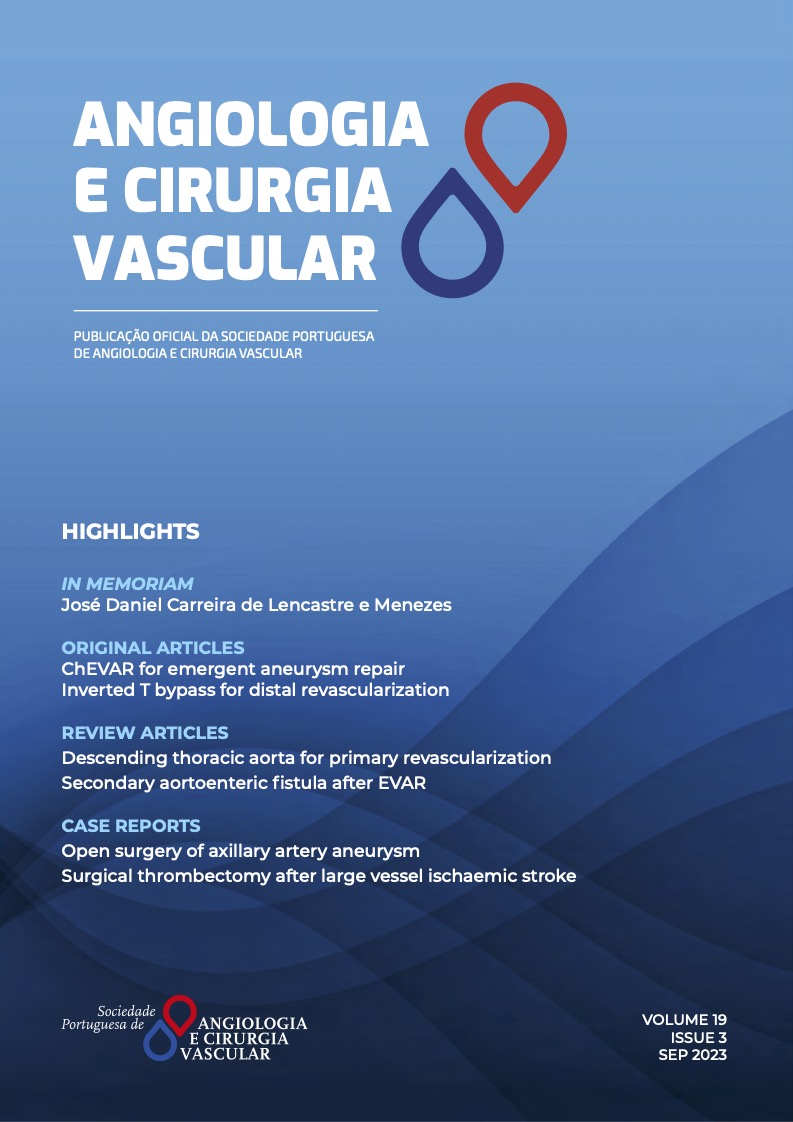Descending Thoracic Aorta as inflow for primary revascularization of aorto-iliac occlusive disease – review of the last 30 years
DOI:
https://doi.org/10.48750/acv.551Keywords:
Descending thoracic aorta bypass, descending Thoracic Aorta, visceral aorta, coral reef aorta, open surgery, chronic limb ischemiaAbstract
INTRODUCTION: The descending thoracic aorta (DTA) has been used as inflow mostly as a secondary option for revascularization after either graft failure/infection or other intra-abdominal pathologies contraindicating a standard abdominal aortic approach. The objective of this review is to summarize current evidence on the use of this inflow site for revascularization procedures.METHODS: A comprehensive electronic literature search was performed, using PubMed and Embase databases. All literature published in English in the last 30 years was considered. The main goal was to assess the feasibility and practicality of implementing this approach in cases of severe and complex aortoiliac lesions.
RESULTS: Our review comprised 11 articles. DTA has been used predominately as a secondary option. The 30-day mortality rate was 4% (9/222). Secondary graft patency at 5-years was generally high across all studies. The use of DTA as inflow has been shown to be a safe and effective option for aorto-iliac reconstruction.
CONCLUSION: DTA can be used safely as an inflow for lower-limb revascularization and it remains an important tool in the vascular surgeon's armamentarium.
Downloads
References
Stevenson JK, Sauvage LR, Harkins HN. A bypass homograft from thoracic aorta to femoral arteries for occlusive vascular disease. Am Surg. 1961;27:632-7
Szilagyi DE, Elliott JP Jr, Smith RF, Reddy DJ, McPharlin M. A thirty-year survey of the reconstructive surgical treatment of aortoiliac occlusive disease. J Vasc Surg. 1986;3:421–36
Hentgen B, Davaine JM, Jayet J, Verscheure D, Couture T, Koskas F. Extra Anatomic Aorto-Iliac Revascularization Using Descending Thoracic Aorta to Bifemoral Bypass in Selected Cases. Ann Vasc Surg. 2022;86:210-8.
Li W, Santana D, Rivas E, Huynh J, Olivas R, Edwards A. Descending thoracic aorta to bilateral femoral artery bypass and thoracic endovascular aortic repair in the management of atypical aortoiliac occlusive disease. J Vasc Surg Cases Innov Tech. 2021;7:718-24
Wistuba MR, Alonso-Pérez M, Al-Sibbai AZ, González-Gay M, Alvarez Marcos F, Camblor LA, et al. Lower limbs revascularization from supraceliac and thoracic aorta. Ann Vasc Surg. 2015;29:1035-9
Reppert AE, Jazaeri O, Babu A, Greenberg JI, Deluka E, Nehler MR, et al. Minimal thoracotomy thoracic bifemoral bypass in the endovascular era. Ann Vasc Surg. 2014;28:1420-5
Fukui S, Paraskevas N, Soury P, Gigou F, Petit MD, Laurian C. Totally videoendoscopic descending thoracic aorta to femoral artery bypass. J Vasc Surg. 2003;37:191-3
Köksal C, Sarikaya S, Zengin M. Thoracofemoral bypass for treatment of juxtarenal aortic occlusion. Asian Cardiovasc Thorac Ann. 2002;10:141-4
Sapienza P, Mingoli A, Feldhaus RJ, Napoli F, Marsan A, Franceschini M, et al. Descending thoracic aorta-to-femoral artery bypass grafts. Am J Surg. 1997;174:662-6
Criado E, Keagy BA. Use of the descending thoracic aorta as an inflow source in aortoiliac reconstruction: indications and long-term results. Ann Vasc Surg. 1994;8:38-47
McCarthy WJ, Mesh CL, McMillan WD, Flinn WR, Pearce WH, Yao JS. Descending thoracic aorta-to-femoral artery bypass: ten years' experience with a durable procedure. J Vasc Surg. 1993;17:336-47
Branchereau A, Magnan PE, Moracchini P, Espinoza H, Mathieu JP. Use of descending thoracic aorta for lower limb revascularisation. Eur J Vasc Surg 1992;6:255-62









